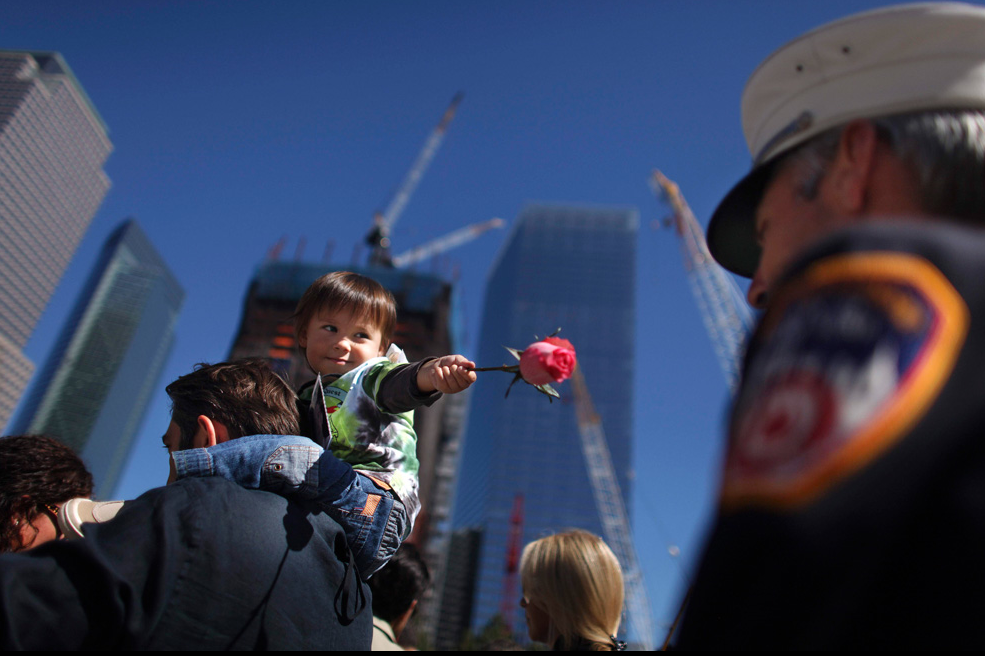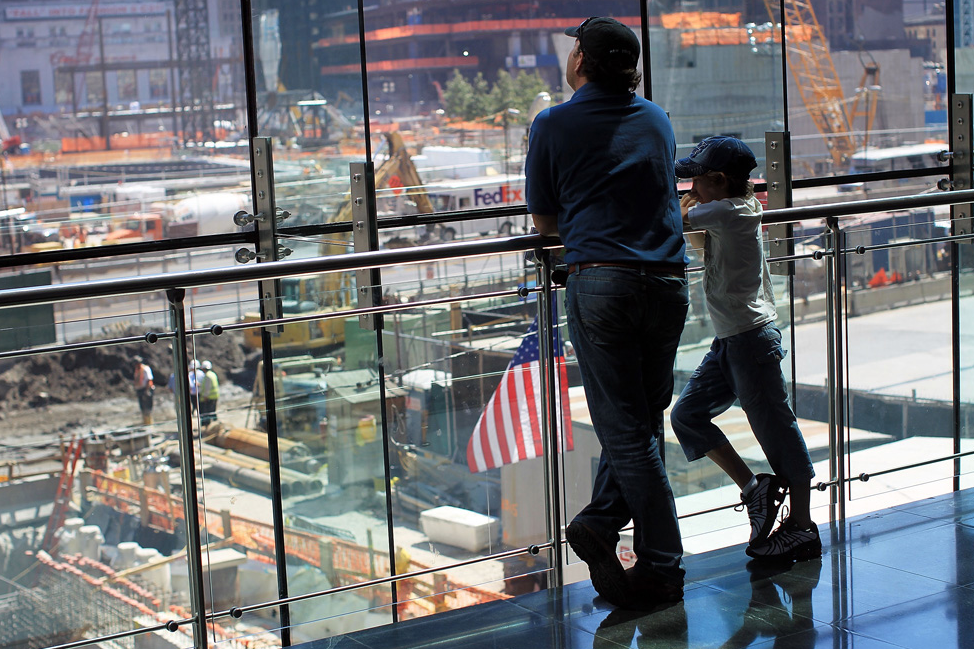I am currently teaching a senior seminar on photojournalism and civic culture and it should come as no surprise that we have spent some time this past week discussing the ways in which photography contributes to how we remember and memorialize the most recent day of infamy in U.S. history. After a recent class one of my students wrote with a question, wondering why it was that there are so many pictures of firefighters at ground zero and no pictures of “the Pennsylvania flight or the DC attack.” Of course, such pictures do exist and they have had some distribution and circulation, but nevertheless the sense of the question is dead on correct: for the most part we have remembered the 9/11 attacks photographically in terms of New York City and the heroic efforts of hundreds of firefighters. The photograph above, which led off a recent slide show on 9/11 remembrance at The Big Picture offers some hints as to why.
The focal point of the photograph is the pink rose being offered by a young boy to a firefighter. The child appears to be happy, safe and secure on his fathers shoulders; but more, his pose—cast against a cloudless, bright blue sky—suggests a return of the innocence that had been purportedly erased once and for all on that fateful day, nine years ago. The dark pink rose, of course, is a symbol of gratitude and appreciation, and its significance here is enhanced by the fact that it is being offered backwards from a representative of a future generation to a representative of the earlier generation whose sacrifices made the present possible. But that is not exactly right, as the offer of gratitude is not simply from one generation to another, but from a citizen to a representative of the state. That the citizen is cast as a pre-adolescent child is very much to the point as it prefigures the parental role of the state. And therein perhaps lies one of the reasons why the firefighter has become such an iconic representation of 9/11, as well as why we see so few pictures of the assault on the Pentagon. Although no one is to blame, images of a successful sneak attack against the nation’s premiere citadel hardly inspires confidence in the ability of the state to protect its citizenry; by the same token, the New York City firefighters more than rose to the task in responding to an attack against a public site.
But there is more going on in this photograph than an allegory of parens patria. And to see what you need to look more closely at the deep background, shot in soft focus, that blends the vivid blue sky with erection of the new tower. That the emergent tower is aligned with the child, and thus identified with a bright future is not incidental, but the bigger point is that the landscape background serves to frame the events on the ground. The effect of that framing is to redirect our remembrances of 9/11 away from a narrative of trauma and loss and towards an unreflexive and over weaning pride—one might even say hubris— in our ability to rebuild and reconstruct, a point underscored throughout the slide show (e.g., here, here, here, and here), but emphasized elsewhere as well, as with photographs such as this one of a father and son appearing to admire the construction site for the new World Trade Center.
The full implications of conflating remembrance (of the past) with rebuilding (the future) are a bit unclear, but they are also somewhat unsettling. Emphasizing the trope of “rebuilding” no doubt draws attention to Ground Zero more than to other sites of 9/11 memory, and in that sense it might help to explain why we see so relatively few photographs from Pennsylvania or Washington D.C, where there are no easily recognizable rebuilding projects. But it should also lead us to notice a potential shift in attention away from the firefighter as hero to the construction worker, and by extension from the state to the private sector. That shift is underscored by the fact that the new tower, originally identified as “Freedom Tower,” has more recently been dubbed “One World Trade Center,” almost as if to shed its connection with the world of state politics and to locate it back in the world of capital and commerce. And what better site for that than New York City? And so it is that the two photographs above seem to work in close tandem with one another: in the first the child must turn around awkwardly to address the firefighter who, it turns out, is barely in the frame, seemingly fading into the past and perhaps soon to be forgotten altogether, or remembered as little more than a relic of a distant time and place; in the second image, father and son comfortably cast the gaze of multiple generations ahead to the future.
It made me recall the words of George Santayana. Not just his prophecy that “Those who cannot remember the past are condemned to repeat it,” but also that “Those who speak most of progress measure it by quantity and not quality.”
Photo Credit: CHang Lee/AP Photo; Spencer Platt/Getty Images.


Discussion